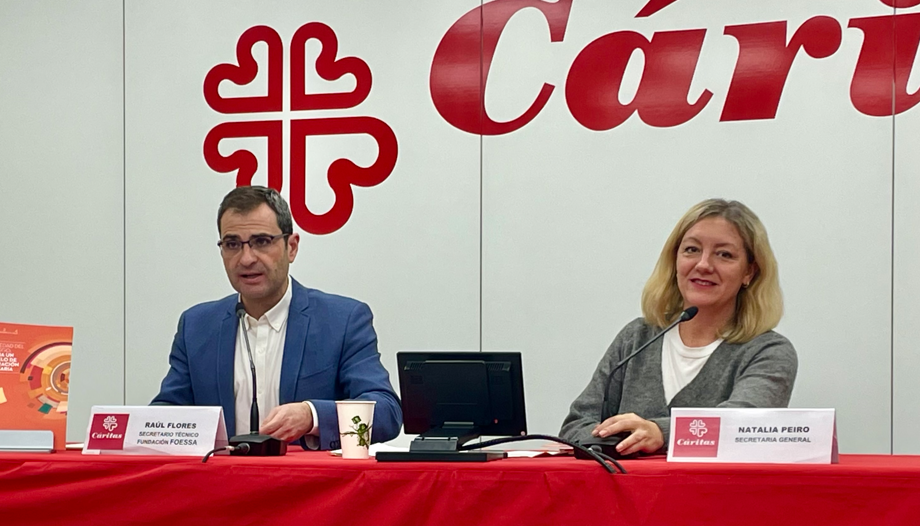Part of Spanish society has not managed to recover from the consequences of the 2008 financial crash. An example of this lack of recovery can be seen in 2024, when 9.4 million people, i.e., 19 % of the population, are in different situations of poverty. social exclusion.
This percentage is considerably higher than in 2007, when 16 % of the population was in these circumstances. And of the current 9.4 million people, 4.3 million are in what is called severe social exclusion.
Caritas has just presented a preview of the results of the IX FOESSA Report, which will be published in the last quarter of 2025, through Natalia Peiro, general secretary of Cáritas Española, and Raúl Flores, technical secretary of the FOESSA Foundation and coordinator of the Cáritas Española Studies Team. Omnes talks to the latter today, but first, two words from Natalia Peiro.
After remembering "all those affected by the severe floods" in Valencia and other localities, the secretary general mentioned the Plan He thanked the many people and organizations for their solidarity. On the other hand, he pointed out that "the positive macro data" should help us to "focus our attention on the most vulnerable".

According to the FOESSA report, our country's households are still not recovering. Mr. Flores, can you reflect this in any figures?
- Indeed, part of Spanish society has not managed to recover from the consequences of the great recession of 2008. An example of this lack of recovery is that in 2024, 9.4 million people, i.e. 19 % of the population, will be in various situations of social exclusion. This percentage is considerably higher than in 2007, when 16% of the population was in this situation.
You refer to millions of people in social exclusion, and even severe social exclusion. Define severe social exclusion, for technical purposes, although it is easy to imagine.
- Social exclusion is much more than material deprivation, it is much more than monetary poverty, economic deprivation. The social exclusion refers to the accumulation of difficulties that influence and determine living conditions, but which have to do with a wide variety of dimensions, such as employment and consumption, but also health, housing, education, political participation rights, social isolation and social conflict. Of the 9.4 million people in social exclusion, 4.3 million are in what we call severe social exclusion.
When we refer to severe social exclusion, what we are trying to express is the accumulation of many difficulties. The vast majority of people in severe social exclusion are affected by three or more of the eight dimensions we observed. This means that they not only have difficulties in employment or economic capacity, but also in areas such as health, housing, education, social isolation or social conflict itself. And some difficulties are added to others, creating chronic and prolonged situations.
In this advance, they focus in particular on the serious problem of housing...
- We have observed how, in the diagnosis, a significant part of society faces difficulties in accessing and maintaining housing. Housing has become the most cross-cutting program for society as a whole, and this makes us bear in mind that our housing protection scheme is far from the schemes in our environment.
Specifically, with regard to public rental housing policy, the public housing stock is barely 2.5 % compared to the European Union average of 8 %.
This means that we must continue to make progress in the creation and extension of this public housing stock that not only serves as a form of priority access and facilitates access to the most vulnerable families, but also acts as a balancer in a housing market that is clearly oriented towards investment and that is still not capable of defending the right to housing.
Which groups are at greater or lesser risk of social exclusion?
-The higher risk of social exclusion on this occasion speaks of what we have called a generation gap. On the one hand, people over 65 continue to reduce their levels of exposure to social exclusion, with levels almost half as high today as in 2007, 8 % of social exclusion among people over 65 compared to 16 % in 2007.
But on the other side of this gap we find the child population and the younger population, among whom their levels of exposure to social exclusion and specifically to severe social exclusion have doubled. It used to be 7 % in 2007 and is now 15 % in 2024.
These are important percentages. If possible, go a little deeper.
- The profile of people in social exclusion, despite being a very varied profile, finds some groups with greater exposure, specifically single-parent families, 29 %, families with children under 24 years of age, 24 %, families with a person with a disability, 24 %, and also people of foreign origin, where social exclusion increases to 47 %, specifically non-EU migrants.
On the other hand, it should also be taken into account that within this profile of groups at greater risk, families and female-headed households should be highlighted. Social exclusion increases to 21 % in these female-headed households, compared to 16 % in male-headed households.
Let's go to employment. It seems that it is no longer an infallible antidote to social exclusion.
- Employment has lost the capacity for social and economic integration that it had historically had. Our society is currently observing how, despite the growth in employment and the reduction in unemployment, we have generated employment in a dual manner. Jobs have been created with inclusive capacity, with adequate remuneration and with stability that allow for vital and family projects, but jobs have also been created that have been added to all that lace of precarious jobs, without stability and with salaries that do not allow a life in conditions in many parts of our country.
In these situations, we have been observing how employment is less and less a factor of protection against poverty and social exclusion. 12 % of working people are in economic poverty and 10 % are in a situation of social exclusion.
Therefore, if employment has ceased to be that mechanism of inclusion, we have to look for elements that help us to go beyond employment as the guarantor of rights and we have to look at public policies that really guarantee those necessary rights for the population.
They have also referred to mental health problems.
- Fortunately, Spanish society is more aware and concerned about mental health as one of the fundamental elements of general health. The COVID-19 crisis made us more aware of the importance of emotional well-being and the difficulties faced by people with mental health problems.
As of today, we are faced with a growing inequality in addressing this issue of mental health: the fundamental inequality between those who can afford a private health scheme and those who have to wait for the waiting lists that the public system presents in these circumstances.
In this sense, we need to strengthen and improve investment in a national health system and in a public health catalog that addresses such important and crucial issues as mental health.
They also study child protection and family policies.
- Beyond the speeches we have been hearing for many years about the need to protect the family and to protect the upbringing stage, which are obviously real and important, we need to move on to facts, and moving on to facts means generating investment and reflecting it in public budgets. The investment that we make today in childhood is far from the investment that is made in the countries of our European environment.
If we only look, for example, at economic benefits per dependent child, Spain only devotes 36 % of what is devoted on average in the European Union. This deficit of investment in children and in family-oriented policies is the reason for the high rates of social exclusion in this part of society.
Finally, they talked about proposals. Summarize four or five.
- As a society, we face a series of important challenges in order to avoid further deepening the risk society. Among all these challenges, we should highlight three elements that are fundamental to curb this risk society. We are going to refer to the challenges of employment, childhood and housing.
Firstly, and referring to employment, it is essential to be aware that there are still many people who are not in the labor market and that many of those who are in the labor market do not have sufficient capacity to ensure minimum living conditions.
This exposes us to the need to continue developing the minimum income guarantee system. We have a wide margin for improvement in this minimum income guarantee system, since today we only dedicate 30 % of the European Union average to insertion incomes.
And together with this need to strengthen monetary social integration, it is also important to consider the need to advance in the right to social inclusion as a fundamental element to improve inclusion itineraries among families. We have already talked about children and housing.











